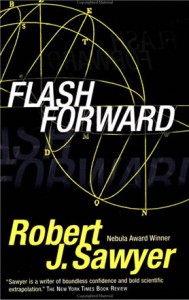 This has nothing to do with The Flash except the title, but I’ve been a fan of Robert J. Sawyer’s novels for several years and figured this site’s audience might still appreciate the review.
This has nothing to do with The Flash except the title, but I’ve been a fan of Robert J. Sawyer’s novels for several years and figured this site’s audience might still appreciate the review.
Flashforward has been in the entertainment news quite a bit the last few weeks with casting for the TV series pilot (more about that later). Strangely enough for a story that’s all about time and the role of the observer, I started reading the novel the day before the first casting news hit.
The novel looks at what happens when, at the moment a scientific experiment begins, everyone on the planet blacks out for two minutes. For those two minutes, everyone sees through the eyes of their future selves, two decades down the line. The world is transformed: first by the millions of accidents caused as drivers, pilots and surgeons lost control of their vehicles and instruments, and second by the survivors’ knowledge of the future.
What follows is an exploration of the nature of time, destiny and free will. Is this a glimpse of the future as it will be, or as it may be? Did the experiment cause the event, or was it a coincidence? Is foreknowledge a blessing or a curse?
Dilemmas
Flashforward is at its best when it focuses on characters’ dilemmas. While it sounds like the TV series will feature a wider cast, the original novel centers on the personal lives of researchers at CERN, particularly the two scientists who designed the experiment: Lloyd Simcoe, a 45-year-old Canadian who is shocked to learn that his impending marriage is doomed to collapse, and Theo Procopides, a 27-year-old Greek who learns that he will be dead by the time the visions come to pass. Lloyd wrestles with his responsibility for the event and whether it’s worth going through with a marriage he knows won’t last. Theo is consumed with preemptively solving his own murder.
There’s a great bit in which a stand-in for the Amazing Randi declares on international television that the future isn’t set, and demonstrates it by smashing a souvenir that he had seen in his vision. The viewpoint character, annoyed at what he considers an obviously inconclusive display, calls up the museum that sold it and orders a new one sent to him. Another character ponders suicide, depressed by his bleak future, but considers: if he does succeed: he will prove beyond a doubt that the future can be changed…which would mean that he could live and still avoid his fate.
Occasionally it stumbles into telling, rather than showing, as when presenting the view of the next twenty years worked out by correlating thousands’ of people’s visions, or when presenting a debate at the United Nations. And it does take a strange turn at one point that reminded me of Robert Charles Wilson’s novel, Darwinia.
Most of the book, though, is an enjoyable look at the different ways that people, organizations, and even nations might react to learning their future.
The Future Isn’t What It Used to Be
This next bit has nothing to do with the quality of the book, only the timing of when I read it. It was published in 1999, but the bulk of the story takes place in April 2009. I read it in December 2008, just five months before its setting, which makes it interesting to compare Sawyer’s ten-year-old predictions to reality. Plus the Large Hadron Collider was in the news quite a bit when it went online just this past September.
He correctly predicted that the world wide web would be significant, but didn’t anticipate that newsgroups would be virtually gone; that countries without anti-spam laws would be havens for spammers, but didn’t anticipate that limited success at enforcement would lead to scofflaws everywhere else flooding 90% of email traffic. Characters submit a new website to hundreds of search engines, rather than focusing on the few top ones (Google was in its infancy back when this was written). Expected that Lasik surgery would make eyeglasses rare by 2009. Missed the mobile phone boom and convergence of PDAs, phones, cameras, etc. (I’m not sure I saw anyone with a cell phone until the narrative caught up with the Flashforward itself, but then the leads all work at a high-energy particle physics lab.) Interestingly, he got the name Pope Benedict XIV correct.
TV Series
Flashforward, or Flash Forward depending on where you look (though I’ve seen people call it Fast Forward as well — not to be confused with Fast-Forward, a.k.a. Buried Alien) is being adapted to a television series for ABC. The network hopes it will hang onto the audience from Lost as that show wraps up. They’re clearly adapting the concept rather than the plot, and according to Sawyer (who is involved in the development) they’ve planned out 5 seasons’ worth of story.
As for casting for the pilot: So far Courtney B. Vance and Jack Davenport, Sonya Walger and Christine Woods have been confirmed, and Joseph Fiennes and John Cho are in negotiations. The author’s blog has more.
Incidentally: While most people know Jack Davenport as Norrington from the Pirates of the Caribbean films, I’ll always think of him as Steve from Coupling. Sorry, Mr. Davenport.

Nice review of a great book. I can’t wait for the series to start. I hope they can keep it interesting.